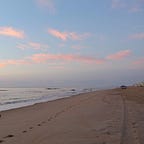Rebuild the Internet
Looking back at my previous post, I think I placed the internet under an overly positive light. It’s definitely true that the internet allowed for the world we live in today. Through the internet, we can do so much more, whether it be with scientific research, marketing, or simply connecting with distant friends and family (the latter has been proven to be especially useful nowadays with COVID-19 and social distancing in effect). But in every corner of the internet, there seems to be a hidden “dark alley” that is easy to overlook among the hundreds of thousands of posts that pop up every minute.
One common dark alley that has been somewhat brought into the light is social media. It’s a known phenomenon that social media can negatively affect mental health. Yet, when having to choose between social media and mental health, which one would people give up? Social media? Mental health? It’s unclear as to what the majority of the population will choose. However, this uncertainty in it itself just shows how important social media has become in our daily lives, raising concerns about excessive reliance on the web.
Another “dark alley” that looms over the internet is cyberbullying and online harassment. Like the negative impacts of social media, these two issues have also been brought out into the light. Without the internet, both cyberbullying and online harassment would not have existed because there would be no platform to encompass them. However, because we have the internet, students are continuously educated about these topics alongside bullying and harassment. This is our world today.
With these ideas in mind, I reimagined the internet to represent what the web means to me and created this drawing:
What:
The drawing shows a library shelf labeled “The Internet” filled with dozens of applications. There is a ladder indicating that there are many shelves below the drawing as well. To the right of the main focus of the drawing, there is a snippet of the shelves located on the other side. Here, the writings are hazy and dark, and they give off a mysterious and frightening aura. This side of the paper is ripped to further add on to this feeling.
Why:
First, I decided to set my drawing in the library because I see the internet as a space mainly where information is shared and received. In the traditional library, that is exactly what is done: knowledge is shared. The ends of the shelves are not drawn because I believe there is no end to the internet; it just keeps growing and growing because there are no limitations on the space it takes up.
As you go up the shelves, there are less applications and more scholarly sources present. I chose to create this distinction to portray the various uses of the internet. This also follows the general age each app is created for; at the bottom, there are games and more entertaining applications for younger kids. Going up the ladder, there are applications that have a higher age restriction. Finally, at the top, there are scholarly and educational applications that older adults utilize more often than younger ones.
The right end of the drawing represents the “dark alley” mentioned above. This does not stand out in the drawing and it hides behind the shelves containing “good” things on the internet. Even in the actual library, people tend to go towards shelves that are at the center instead of ones that are hard to find in deep corners. This area is filled with negative words and an eye to represent spying. The edge of this paper is torn to represent how the “dark alley” still remains unclear for many people that utilize the internet. No one can fully comprehend the AI behind it.
How:
To create this drawing, I searched (on the internet) the icons of popular applications. I also included some of the applications that I use often. While I was looking up icons, I found it funny because I was able to identify all of them without having to look up its name. See if you can name them all!
I decided to outline each application with their respective colors in pen. I chose not to fill in the colors because I imagine the internet as a very plain space that is colored by the users themselves.
The process that this project took me through made me seriously rethink how I perceived the internet. I started off the project with knowing the good and the bad of the internet, but ended without knowing the good and the bad.
#Dgst101 (2/15–2/21)
